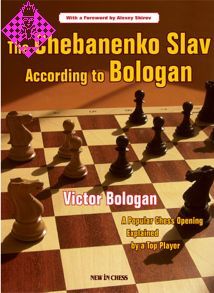Artikelnummer
LOBOLTCS
Autor
The Chebanenko Slav - according to Bologan
238 Seiten, kartoniert, New in Chess, 1. Auflage 2008
Final vergriffen
Chebanenko's move 4...a6 in the Slav Defence has grown into one of the main systems for Black. It is an extremely flexible and almost uniweapon against the Queen's Gambit.
The Chebanenko Slav is very popular among top players such as Victor Bologan, the author of this book, and Alexey Shirov. Club and internet players like it because it offers Black solidity as well as active counin all lines.
The Chebanenko Slav According to Bologan gives full coverage of all the variations starting with 3.Nf3 Nf6 4.Nc3 a6 and the ultra-modern ideas behind this system.
But this book also pays homage to the colourful inventor of this variaVyacheslav Andreevich Chebanenko. This enigmatic teacher was the master brain behind a generation of strong players.
Foreword by Alexey Shirov
We all know chess theory nowadays. Some of us know less, others more. But do we really know the history of chess theory, its development? And, of course, the next question would be - is it imporat all? Judging by my personal expethe answer is positive. Many teenof today want to know how chess was before they were born.
Our generation (Viorel Bologan is just half a year older than me) have enjoyed all the benefits of 'technical progress' in chess. We were still very young and fresh when the use of databases and analysis engines became the most convenient form of working on chess and the experiwe had before prevented us from underestimating the human touch, so the work with new technologies could beespecially effective. But I think the nostalgic memories of times when everywas done with the desire to disnew things, when the search for the truth in chess was sometimes absorbing, those memories simply can't be taken away. As well as memories of people who never knew the modern times.
The year 1997 was sad for both Viorel and me. The chess community lost two personalities who had devoted all their life into chess investigation - the Latvian Alvis Vitolinsh and the Moldavian Vyacheslav Chebanenko. I was supposed to write a tribute to my countryman but I haven't done it yet - who knows when I will be able to. Therefore it's important for me to see that Viorel has done so tohis former trainer and spiritual guru. And I should say that the 4...a6 Slav is still only a small part of Chebanenko's contribution to chess, his other system 1.c4 e5 2.Nc3 Bb4 3.Nd5 Be7!? immecomes to mind as I played it a few weeks ago against Levon Aronian in Morelia 2008 and achieved a better posiHis old ideas in the Rossolimo Vari(1.e4 c5 2.Nf3 Nc6 3.Bb5 g6 4.Bxc6 dxc6 5.d3 etc.) are very importoo, practically the whole modern theory of that system is just the continuaof old Moldavian investigations.
I first heard the name of Chebanenko beof the 4...a6 Slav. A Latvian of my age, Kaspars Ramma (he was a fine posiplayer in his youth but then sudstopped competing), successfully employed it in the second half of the eighties and once he annotated his best effort for the Riga magazine Shakhmaty or Sahs, mentioning the author of the opening, of course, and also referring to Viktor Gavrikov's article. When I saw those comments I distrusted everybody involved, as I dogmatically thought that a tempo could not be wasted like this. I still needed to meet Chebanenko and beViorel's friend to change my opin
At the beginning Vyacheslav Chebanenko was like a ghost for me. He never left his hotel room. During some junior compeI even mistook Boris Itkis for him, because Boris was visible with Moldavian youngsters but he was unknown to me, while Chebanenko's name would always be mentioned when one was preparing against the Moldavian players. I got to know Vyacheslav Andreevich personally in 1988 when he was helping Oratovsky in his match versus Kramnik in Moscow and I attended the meeting of Botvinnik with Jeroen Piket at the same time and venue. Of course, the place I first met Chebanenko was his hotel room and we immediately started analysing the Slav with 4...a6 which I tried to 'refute', but in vain.
Vyacheslav Chebanenko would normally try not to let his knowledge be spread outside the Moldavian chess school, but with me he made an exception, perhaps because I was Viorel's friend. He also inme to his girl students and one of them was my girlfriend for a short while. I wouldn't mention this if it were not for the fact that later on in some of my games I employed a move that he had taught the girl (6...Bg4 after 1.d4 d5 2.c4 c6 3.Nc3 Nf6 4.cxd5 cxd5 5.Bf4 Nc6 6.e3), so the Moldavian school definitely had a certain impact on my chess.
So, I should say that Vyacheslav Chebanenko was a nice and a quiet man in daily life and a true workaholic in chess research, and one of the most retrainers of his time. He left this world too early but his systems are still alive. Even though he was not a tactician at all, his chess strategy has passed the test of time and technology.
Finally I should thank Viorel Bologan for a tremendous job of unifying the modern discoveries in the 4...a6 system with its historical background. Now the reader has everything he needs to know - the old strategic ideas and the latest concrete nuances. And the fact that sometimes pieces don't get exchanged before move 20 shows how fascinating and complex the opening is.
Play 4...a6 in the Slav! I used to think it was a loss of tempo but it is not!
Alexey Shirov
Tarragona, 16th of March 2008
The Chebanenko Slav is very popular among top players such as Victor Bologan, the author of this book, and Alexey Shirov. Club and internet players like it because it offers Black solidity as well as active counin all lines.
The Chebanenko Slav According to Bologan gives full coverage of all the variations starting with 3.Nf3 Nf6 4.Nc3 a6 and the ultra-modern ideas behind this system.
But this book also pays homage to the colourful inventor of this variaVyacheslav Andreevich Chebanenko. This enigmatic teacher was the master brain behind a generation of strong players.
Foreword by Alexey Shirov
We all know chess theory nowadays. Some of us know less, others more. But do we really know the history of chess theory, its development? And, of course, the next question would be - is it imporat all? Judging by my personal expethe answer is positive. Many teenof today want to know how chess was before they were born.
Our generation (Viorel Bologan is just half a year older than me) have enjoyed all the benefits of 'technical progress' in chess. We were still very young and fresh when the use of databases and analysis engines became the most convenient form of working on chess and the experiwe had before prevented us from underestimating the human touch, so the work with new technologies could beespecially effective. But I think the nostalgic memories of times when everywas done with the desire to disnew things, when the search for the truth in chess was sometimes absorbing, those memories simply can't be taken away. As well as memories of people who never knew the modern times.
The year 1997 was sad for both Viorel and me. The chess community lost two personalities who had devoted all their life into chess investigation - the Latvian Alvis Vitolinsh and the Moldavian Vyacheslav Chebanenko. I was supposed to write a tribute to my countryman but I haven't done it yet - who knows when I will be able to. Therefore it's important for me to see that Viorel has done so tohis former trainer and spiritual guru. And I should say that the 4...a6 Slav is still only a small part of Chebanenko's contribution to chess, his other system 1.c4 e5 2.Nc3 Bb4 3.Nd5 Be7!? immecomes to mind as I played it a few weeks ago against Levon Aronian in Morelia 2008 and achieved a better posiHis old ideas in the Rossolimo Vari(1.e4 c5 2.Nf3 Nc6 3.Bb5 g6 4.Bxc6 dxc6 5.d3 etc.) are very importoo, practically the whole modern theory of that system is just the continuaof old Moldavian investigations.
I first heard the name of Chebanenko beof the 4...a6 Slav. A Latvian of my age, Kaspars Ramma (he was a fine posiplayer in his youth but then sudstopped competing), successfully employed it in the second half of the eighties and once he annotated his best effort for the Riga magazine Shakhmaty or Sahs, mentioning the author of the opening, of course, and also referring to Viktor Gavrikov's article. When I saw those comments I distrusted everybody involved, as I dogmatically thought that a tempo could not be wasted like this. I still needed to meet Chebanenko and beViorel's friend to change my opin
At the beginning Vyacheslav Chebanenko was like a ghost for me. He never left his hotel room. During some junior compeI even mistook Boris Itkis for him, because Boris was visible with Moldavian youngsters but he was unknown to me, while Chebanenko's name would always be mentioned when one was preparing against the Moldavian players. I got to know Vyacheslav Andreevich personally in 1988 when he was helping Oratovsky in his match versus Kramnik in Moscow and I attended the meeting of Botvinnik with Jeroen Piket at the same time and venue. Of course, the place I first met Chebanenko was his hotel room and we immediately started analysing the Slav with 4...a6 which I tried to 'refute', but in vain.
Vyacheslav Chebanenko would normally try not to let his knowledge be spread outside the Moldavian chess school, but with me he made an exception, perhaps because I was Viorel's friend. He also inme to his girl students and one of them was my girlfriend for a short while. I wouldn't mention this if it were not for the fact that later on in some of my games I employed a move that he had taught the girl (6...Bg4 after 1.d4 d5 2.c4 c6 3.Nc3 Nf6 4.cxd5 cxd5 5.Bf4 Nc6 6.e3), so the Moldavian school definitely had a certain impact on my chess.
So, I should say that Vyacheslav Chebanenko was a nice and a quiet man in daily life and a true workaholic in chess research, and one of the most retrainers of his time. He left this world too early but his systems are still alive. Even though he was not a tactician at all, his chess strategy has passed the test of time and technology.
Finally I should thank Viorel Bologan for a tremendous job of unifying the modern discoveries in the 4...a6 system with its historical background. Now the reader has everything he needs to know - the old strategic ideas and the latest concrete nuances. And the fact that sometimes pieces don't get exchanged before move 20 shows how fascinating and complex the opening is.
Play 4...a6 in the Slav! I used to think it was a loss of tempo but it is not!
Alexey Shirov
Tarragona, 16th of March 2008
| EAN | 9789056912468 |
|---|---|
| Gewicht | 490 g |
| Hersteller | New in Chess |
| Breite | 17 cm |
| Höhe | 23,5 cm |
| Medium | Buch |
| Erscheinungsjahr | 2008 |
| Autor | Victor Bologan |
| Sprache | Englisch |
| Auflage | 1 |
| ISBN-13 | 9789056912468 |
| Seiten | 238 |
| Einband | kartoniert |
| Name | New in Chess B.V. |
|---|---|
| Adresse | Rochdalestraat 4 a Alkmaar 1814 TH Niederlande |
| Internet | www.newinchess.com |
| nic@newinchess.com |
009 Foreword by Alexey Shirov
011 Introduction
029 Part I - Various Replies on Move 5
030 Chapter 1: The Exchange 5.cxd5
041 Chapter 2: The Cunning 5.h3
044 Chapter 3: The Uncommon 5.Qc2
048 Chapter 4: Pressure on Black's Pawns: 5.Qb3
060 Chapter 5: Catalan-Style: 5.g3
072 Chapter 6: Developing: 5.Bf4
076 Chapter 7: The Rare 5.Bg5
081 Part II - Inserting 5.a4 e6
082 Chapter 8: Catalan-Style: 6.g3
093 Chapter 9: The Timid 6.e3
097 Chapter 10: Pinning: 6.Bg5
117 Part III -The Insidious 5.Ne5
118 Chapter 11: The Forcing 5...b5
121 Chapter 12: The Main Move: 5...e6
125 Chapter 13: The Exchange 5...dxc4
129 Chapter 14: Chebanenko's Favourite: 5...Nbd7
135 Part IV - The Solid 5.e3
136 Chapter 15: Minor Replies: 6.cxd5, 6.b3
146 Chapter 16: Seizing Space: 6.c5 Various
159 Chapter 17: Seizing Space: 6.c5 Nbd7
165 Part V-The Strategic 5.c5
166 Chapter 18: The Provocation 5...Bg4
170 Chapter 19: The Rare 5...g6
173 Chapter 20: The Sortie 5...Bf5
180 Chapter 21: Flexibility: 5...Nbd7 6.h3
190 Chapter 22: Flexibility: 5...Nbd7 6.Bf4
213 Practical Examples
225 Index of Variations
231 Index of Players
238 New In Chess Code System
011 Introduction
029 Part I - Various Replies on Move 5
030 Chapter 1: The Exchange 5.cxd5
041 Chapter 2: The Cunning 5.h3
044 Chapter 3: The Uncommon 5.Qc2
048 Chapter 4: Pressure on Black's Pawns: 5.Qb3
060 Chapter 5: Catalan-Style: 5.g3
072 Chapter 6: Developing: 5.Bf4
076 Chapter 7: The Rare 5.Bg5
081 Part II - Inserting 5.a4 e6
082 Chapter 8: Catalan-Style: 6.g3
093 Chapter 9: The Timid 6.e3
097 Chapter 10: Pinning: 6.Bg5
117 Part III -The Insidious 5.Ne5
118 Chapter 11: The Forcing 5...b5
121 Chapter 12: The Main Move: 5...e6
125 Chapter 13: The Exchange 5...dxc4
129 Chapter 14: Chebanenko's Favourite: 5...Nbd7
135 Part IV - The Solid 5.e3
136 Chapter 15: Minor Replies: 6.cxd5, 6.b3
146 Chapter 16: Seizing Space: 6.c5 Various
159 Chapter 17: Seizing Space: 6.c5 Nbd7
165 Part V-The Strategic 5.c5
166 Chapter 18: The Provocation 5...Bg4
170 Chapter 19: The Rare 5...g6
173 Chapter 20: The Sortie 5...Bf5
180 Chapter 21: Flexibility: 5...Nbd7 6.h3
190 Chapter 22: Flexibility: 5...Nbd7 6.Bf4
213 Practical Examples
225 Index of Variations
231 Index of Players
238 New In Chess Code System
Fundgrube von Ideen
Das Buch ist schon seit einigen Monaten auf dem Markt, und ich habe nur enthusiastische Lobesdarauf gelesen. Also war ich einigermaßen gespannt, als ich es selbst in Händen hielt. Ein Eröffnungsbuch von einem Spieder Sonderklasse wie Bologan ist grundsätzlich schon spannend, obwohl ich in der Vergangenheit häufig von solchen Werken entäuscht war. Ich hatte ab und zu den Eindruck, der Name wurde nur zu Marketingzwecken verDavon kann hier aber keine Rede sein. Es wird sehr schnell klar, dass Bologan seine Kompetenz in die Waagschale wirft, um ein erstklassiges Buch zu schreiben... nicht zuletzt auch, um Wjatscheslaw Tschebanenko, Bologans Landsmann und Urhedieses Eröffnungssystems, ein Denkmal zu setzen. So beschreibt er in der Einleitung auch nicht nur die Geschichte des Systems, sonauch seine persönliche Bezu Tschebanenko.
Behandelt wird nur das eigentliTschebanenko-System, das nach 1. d4 d5 2. c4 c6 3. Sf3 Sf6 4. Sc3 a6 entsteht. Spielt Weiß dagegen 3. Sf3 Sf6 4. e3 oder 3. Sc3 Sf6 4. e3, kann Schwarz zwar auch 4.... a6 spielen, muss sich aber an anderer Stelle detaillierten Rat suchen, falls Weiß nicht mit 5. Sc3 bzw. 5. Sf3 wieder ins Hauptsystem übergeht. Die einzige Ausnahme bildet die Abtauschvariante, in der Bologan auch Aufstellungen mit einem weißen Königsspringer auf e2 behandelt (der Beweggrund dafür wird nicht recht klar).
Das Buch ist eine Fundgrube für neue Varianten und Ideen, aber Bologan ist methodisch oft nicht ganz konsequent. Man spürt häusein tiefes Schachverständnis und seine genaue Kenntnis dieser Eröffnung, aber er hinterlässt hin und wieder den Eindruck eines zerstreuten Professors, der die Maabsolut beherrscht, aber manchmal den Faden verliert. Nehmen wir ein Beispiel: Ich hatte besonderes Interesse am Abspiel 5. c5 Sbd7 6. Lf4 Sh5 7. Lg5!?. Es wurde von Chris Ward in Dangerous Weapons: The Queen's Gambit empfohlen, und ich hatte es bereits selbst gespielt. Weiß will h7-h6 provozieren, bevor er den „Normalzug" Lf4/g5-d2 ausührt. Geht es weiter mit 7. ... h6 8. Ld2 Shf6 9. Lf4 Sh5, kann Weiß 10. Le5 mit mehr Wirkung spielen, da sich Schwarz nach 10. ... Sxe5 11. Sxe5 den Zug f7-f6 wegen des Lochs auf g6 nicht mehr leisten kann. In der Position nach 9. Lf4 behandelt Ward ausschließlich 9. ... Sh5, während Bologan diesen Zug nur im Nebentext erwähnt und als Hauptvariante das energi9.... g5 führt... was „zufällig" auch Tönu Tiits im Ragosin-Memorial gegen mich spielte. Es folg10. Lg3 Lg711. e3 (Ich spielte 11. Dc2, weil ich mir noch Hoffnungen auf e2-e4 in einem einzigen Zug machte. Da ich dann doch auf e2-e3 zurückgreifen musste, ist 11. e3 zumindest flexibler und wahrauch stärker.) 11.... Sh5.
Bologan schreibt, der Läufer müsjetzt ziehen, und er setzt die Variante mit 12. Le5 fort und kommt zu dem Schluss, Schwarz habe Ausgleich. Im Nebentext zu 12. Le5 führt er auf sechs Zeilen aus, warum 12. Ld3 Sxg3 13. hxg3 e5 weniger gut ist und Schwarz eventuell sogar Vorteil bekommt. Der Leser (und vielleicht zukünftiTschebanenko-Anhänger) ist zufrieden... bis ihm plötzlich aufällt, dass unter diesen sechs Zeinoch zwei weitere folgen, in denen es - scheinbar beiläufig -heißt, Weiß behielte allerdings eine unstrittige Initiative nach 12. Le2 Sxg3 13. hxg3 b6 14. cxb6 Dxb6 15. Dc2. Wie bitte?? Hieß es nicht eben noch, der Läufer (auf g3) müsse ziehen? Und bewegte sich nicht alles logisch auf schwarAusgleich zu? Und jetzt das! Geht man auf der Suche nach Auswieder weiter nach vorne, stößt man auf 9.... Shf6, was man laut Bologan auch spielen könne, und er gibt kommentarlos eine Partie, die im 25. Zug remis endet.
Ob das jetzt Ausgleich bedeutet, kann sich der Leser selbst überleaber nach der Partiefolge 10. Le5 Sxe5 11.Sxe5 Sf6 12.e4 Le6 13. exd5 Lxd5 14. Sxd5 Sxd5 15. Ld3 ist Schwarz meiner Einschätzung nach noch nicht aller Sorgen ledig. Hat jetzt also plötzlich Weiß Vorin dieser Variante? So ganz kann das aufgrund des präsenMaterials nicht beantworwerden, aber es stellt sich durchaus die Frage, warum Schwarz nach 12. Le2 Sxg3 13. hxg3 nicht analog zur Variante nach 12. Ld3 und im Einklang mit der Logik der vorausgegangenen Züge einfach 13. ... e5(!) spielt. Damit dürfte Schwarz wohl Auserreichen oder ihm zuminsehr nahe kommen. Eigenthat Bologan dem Leser in dieVariante das gesamte Material an die Hand gegeben, das er braucht: Er erwähnt 9. ... g5 (das sehr wahrscheinlich stärker ist als 9. ... Shf6) und gewinnt damit an dieser Stelle locker das „Duell" mit Chris Ward, er führt 12. Le5 zum Ausgleich von Schwarz aus, und er präsentiert die zentrale Idee Sh5xg3 & e7-e5 für den Fall, dass Weiß den Läufer auf g3 stehen lässt, und trotzdem ist er dabei inkonsequent und verunsichert den Leser unnötigerweise.
Ein anderes, etwas verwirrendes Abspiel ist die Nebenvariante 5. Dc2. In der Einleitung zum Kapitel schreibt Bologan, 5. Dc2 sei ein seltener Zug, der jenen Spielern zu empfehlen sei, die keinen Gedächtniswettstreit austragen wollten, sondern den Kampf suchIn der Hauptvariante kommt er aber zu dem Ergebnis, dass Schwarz nach elf Zügen klaren Vorteil hat. Wenn ich ehrlich sein soll: Auf diese Art Kampf kann ich als Weißer verzichten... Bei nähePrüfung ist alles zwar nicht ganz so schlimm, da vor allem die weißen Züge 10 und 11 fehlerhaft waren, aber sehr gutes Spiel erält Schwarz nach 5.... b5 6. b3 g6 7. e4 dxe4 8. Sxe4 Sxe4 9. Dxe4 Lg7 allemal, und eine Empfehlung für einen kampfeswilligen Spieler ist das nicht.
Man stößt im Buch immer wieder plötzlich auf Abspiele, die den ganzen Tenor der Variante oder des Kapitels auf den Kopf zu stelscheinen. Gleichzeitig finden sich aber zahlreiche neue Ideen und strategische Erläuterungen, die man nicht einfach in Datenfindet und die auch nicht ein x-beliebiger Autor aus dem Ärmel schütteln kann. Wenn der Leser auf solche Ungereimtheiten stößt, hat er keine Wahl: Er muss sich hinsetzen und sich selbst ein Bild machen (was er eigentlich bei jedem Eröffnungsbuch machen sollte - vielleicht ist das alles ja eine subtile Methode von Bologan, seine Leser zum kritischen Mitzu veranlassen!?). Noch einmal: Der Leser findet eine Menwertvolles Material in dem Buch, aber er muss selbst aktiv damit arbeiten. Es geht ihm dabei ein bisschen wie einem Hobbyder es gewohnt ist, Fischfilets zu verarbeiten und plötzlich ratlos vor einem ganzen Fisch steht und sich die Frage stellen muss, wie der nun zu filetieren sei.
Mit freundlicher Genehmigung
Klaus Kögler, Kaissiber 34**********Neben dem „Play the Slav" von James Vigus versucht nun auch GM Viktor Bologan einer breiten Leserschaft diese Eröffnung schmackhaft zu machen. Dabei verlässt sich der Autor auf den Chebanenko-Slawen (1.d4 d5 2.c4 c6 3.Sc3 Sf6 4.Sf3 a6), Recht gibt ihm kein Geringerer als Alexei Shirov im Vorwort mit „play 4…a6 in the Slav! I used to think it was a loss of tempo but it is not!" Zahlreiche Partien in letzter Zeit haben bewiesen, dass der seltsam anmutende Zug 4...a6 durchaus seine Existenzberechtigung besitzt. Bologan analysiert sehr ausschweifend alle möglichen weißen Antwortzüge auf 4…a6, dabei stützt er sich aber nicht nur auf bereits veröffentlichtes Material sondern bringt sehr viele eigene Ideen mit ein, ganz ähnlich dem vorzüglichen Werk von Morosewitsch über die Tschigorin-Verteidigung im gleichen Verlag. Vieles ist zwar arg variantenlastig und manchmal möchte man einen Seufzer der Verzweiflung gen Himmel schicken ob soviel Analysefreudigkeit des Autors, wird aber durch auflockernde Textpassagen und interessanten Erläuterungen wieder besänftigt. Bologan ist ein waschechter Profi in Sachen Slawisch, in jeder Zeile seiner Bemerkungen spürt man sein umfangreiches Wissen und davon kann man nur profitieren!
Zum Inhalt:
Nach 1.d4 d5 2.c4 c6 3.Sc3 Sf6 4.Sf3 a6 gliedert Bologan das Material in fünf große Kapitel (verschiedene Antworten des Weißen im 5.Zug, 5.a4 e6, 5.Se5, 5.e3 sowie 5.c5). Im Anschluss daran folgen 34 ausgewählte Stellungen aus dieser Eröffnung, in der man den richtigen Zug finden soll. Anhand der Erläuterungen des Autors am Anfang des Buches sowie zwischen den Analysen dürfte man so manche Lösung finden, eine sehr gute und für die Praxis brauchbare Idee und Übung!
Ein rundum zufrieden stellendes Partien-, Spieler-, Variantenverzeichnis runden das gelungene Werk ab.
Wie gefährlich dieses System sein kann, zeigte Topalov in einer sehenswerten Partie gegen Van Wely:
Van Wely,L (2647) - Topalov,V (2801) [D15]
Corus Wijk aan Zee 2006
1.d4 d5 2.c4 c6 3.Sf3 Sf6 4.Sc3 a6 5.a4 e6 6.Lg5 h6 7.Lh4 dxc4 8.e3 b5 9.axb5 cxb5 10.Lxf6 gxf6 11.Sxb5 axb5 12.Txa8 Lb4+ 13.Ke2 Lb7 14.Ta1 f5 15.Se5 Tg8 16.f4 Sc6 17.Sf3 Sa5 18.Kf2 Sb3 19.Ta7 Le4 20.Ta2 e5 21.fxe5 f4 22.Le2 fxe3+ 23.Kxe3 Dd5 24.g3 Sxd4 25.Sxd4 Lxh1 26.Lf3 Dxe5+ 27.Kf2 Lc5 28.Lxh1 Lxd4+ 29.Kf1 Tg5 30.Lf3 Kf8 31.Kg2 De3 32.Kh3 Kg7 33.b3 cxb3 34.Ta3 b4 35.Txb3 Lc3 36.De2 Dc5 37.Dd3 Dc8+ 38.Kg2 Ta5 39.Dc2 De6 40.Db1 Ta1 41.Dc2 Ld4 42.Ld1 De1 43.Lf3 Df1# 0-1
Viktor Bologan lieferte mit seinem Erstlingswerk über seine Schachkarriere bereits einen modernen Klassiker ab, hier bei seinem zweiten Werk übertrifft er sich noch einmal selbst.
Bologan hat hervorragende Analysen und präzise Kommentare zu einem komplexen Eröffnungssystem abgeliefert, eine rundum saubere und gewissenhafte Arbeit!
Mit freundlicher Genehmigung
Martin Rieger, www.freechess.info**********
From the Foreword by Alexey Shirov:
'Play 4...a6 in the Slav! I used to think it was a loss of tempo but it is not!'
Jeremy Silman, author of 'How to Reassess Your Chess':
"Stands head and shoulders above everything else on the subject, and is how I wish every advanced opening book would be written."
John Saunders, British Chess Magazine:
"A very interesting book on this interesting system which has gained popularity over the past ten years or so. It is a well-researched book by a very strong player who has a growing reputation as an entertaining writer."
Arne Moll, ChessVibes:
"Extremely well-researched and written with a lot of passion."
Bill McGeary, ChessVille:
"Volumes like this do not come along very often and this will be the standard for the Chebanenko for years to come."
James Vigus, author of 'Play the Slav':
"The quantity of new analysis is impressive."
IM John Donaldson:
"Victor Bologan, whose book of his best games was widely praised, has another winner here."
Carsten Hansen, ChessCafe:
"For serious players of 1.d4 and the Slav, this book is a must. It is simply outstanding."
Joe Petrolito, Australasian Chess Magazine:
"An excellent example of how an opening book should be wrtten."
GM Glenn Flear, Yearbook:
"There aren't many books around by players of this calibre, nor are there many that offer so much new material."
FreeChess:
"Victor Bologan's first book, on his chess career, was already a modern classic. This one, his second book, is even better."
Das Buch ist schon seit einigen Monaten auf dem Markt, und ich habe nur enthusiastische Lobesdarauf gelesen. Also war ich einigermaßen gespannt, als ich es selbst in Händen hielt. Ein Eröffnungsbuch von einem Spieder Sonderklasse wie Bologan ist grundsätzlich schon spannend, obwohl ich in der Vergangenheit häufig von solchen Werken entäuscht war. Ich hatte ab und zu den Eindruck, der Name wurde nur zu Marketingzwecken verDavon kann hier aber keine Rede sein. Es wird sehr schnell klar, dass Bologan seine Kompetenz in die Waagschale wirft, um ein erstklassiges Buch zu schreiben... nicht zuletzt auch, um Wjatscheslaw Tschebanenko, Bologans Landsmann und Urhedieses Eröffnungssystems, ein Denkmal zu setzen. So beschreibt er in der Einleitung auch nicht nur die Geschichte des Systems, sonauch seine persönliche Bezu Tschebanenko.
Behandelt wird nur das eigentliTschebanenko-System, das nach 1. d4 d5 2. c4 c6 3. Sf3 Sf6 4. Sc3 a6 entsteht. Spielt Weiß dagegen 3. Sf3 Sf6 4. e3 oder 3. Sc3 Sf6 4. e3, kann Schwarz zwar auch 4.... a6 spielen, muss sich aber an anderer Stelle detaillierten Rat suchen, falls Weiß nicht mit 5. Sc3 bzw. 5. Sf3 wieder ins Hauptsystem übergeht. Die einzige Ausnahme bildet die Abtauschvariante, in der Bologan auch Aufstellungen mit einem weißen Königsspringer auf e2 behandelt (der Beweggrund dafür wird nicht recht klar).
Das Buch ist eine Fundgrube für neue Varianten und Ideen, aber Bologan ist methodisch oft nicht ganz konsequent. Man spürt häusein tiefes Schachverständnis und seine genaue Kenntnis dieser Eröffnung, aber er hinterlässt hin und wieder den Eindruck eines zerstreuten Professors, der die Maabsolut beherrscht, aber manchmal den Faden verliert. Nehmen wir ein Beispiel: Ich hatte besonderes Interesse am Abspiel 5. c5 Sbd7 6. Lf4 Sh5 7. Lg5!?. Es wurde von Chris Ward in Dangerous Weapons: The Queen's Gambit empfohlen, und ich hatte es bereits selbst gespielt. Weiß will h7-h6 provozieren, bevor er den „Normalzug" Lf4/g5-d2 ausührt. Geht es weiter mit 7. ... h6 8. Ld2 Shf6 9. Lf4 Sh5, kann Weiß 10. Le5 mit mehr Wirkung spielen, da sich Schwarz nach 10. ... Sxe5 11. Sxe5 den Zug f7-f6 wegen des Lochs auf g6 nicht mehr leisten kann. In der Position nach 9. Lf4 behandelt Ward ausschließlich 9. ... Sh5, während Bologan diesen Zug nur im Nebentext erwähnt und als Hauptvariante das energi9.... g5 führt... was „zufällig" auch Tönu Tiits im Ragosin-Memorial gegen mich spielte. Es folg10. Lg3 Lg711. e3 (Ich spielte 11. Dc2, weil ich mir noch Hoffnungen auf e2-e4 in einem einzigen Zug machte. Da ich dann doch auf e2-e3 zurückgreifen musste, ist 11. e3 zumindest flexibler und wahrauch stärker.) 11.... Sh5.
Bologan schreibt, der Läufer müsjetzt ziehen, und er setzt die Variante mit 12. Le5 fort und kommt zu dem Schluss, Schwarz habe Ausgleich. Im Nebentext zu 12. Le5 führt er auf sechs Zeilen aus, warum 12. Ld3 Sxg3 13. hxg3 e5 weniger gut ist und Schwarz eventuell sogar Vorteil bekommt. Der Leser (und vielleicht zukünftiTschebanenko-Anhänger) ist zufrieden... bis ihm plötzlich aufällt, dass unter diesen sechs Zeinoch zwei weitere folgen, in denen es - scheinbar beiläufig -heißt, Weiß behielte allerdings eine unstrittige Initiative nach 12. Le2 Sxg3 13. hxg3 b6 14. cxb6 Dxb6 15. Dc2. Wie bitte?? Hieß es nicht eben noch, der Läufer (auf g3) müsse ziehen? Und bewegte sich nicht alles logisch auf schwarAusgleich zu? Und jetzt das! Geht man auf der Suche nach Auswieder weiter nach vorne, stößt man auf 9.... Shf6, was man laut Bologan auch spielen könne, und er gibt kommentarlos eine Partie, die im 25. Zug remis endet.
Ob das jetzt Ausgleich bedeutet, kann sich der Leser selbst überleaber nach der Partiefolge 10. Le5 Sxe5 11.Sxe5 Sf6 12.e4 Le6 13. exd5 Lxd5 14. Sxd5 Sxd5 15. Ld3 ist Schwarz meiner Einschätzung nach noch nicht aller Sorgen ledig. Hat jetzt also plötzlich Weiß Vorin dieser Variante? So ganz kann das aufgrund des präsenMaterials nicht beantworwerden, aber es stellt sich durchaus die Frage, warum Schwarz nach 12. Le2 Sxg3 13. hxg3 nicht analog zur Variante nach 12. Ld3 und im Einklang mit der Logik der vorausgegangenen Züge einfach 13. ... e5(!) spielt. Damit dürfte Schwarz wohl Auserreichen oder ihm zuminsehr nahe kommen. Eigenthat Bologan dem Leser in dieVariante das gesamte Material an die Hand gegeben, das er braucht: Er erwähnt 9. ... g5 (das sehr wahrscheinlich stärker ist als 9. ... Shf6) und gewinnt damit an dieser Stelle locker das „Duell" mit Chris Ward, er führt 12. Le5 zum Ausgleich von Schwarz aus, und er präsentiert die zentrale Idee Sh5xg3 & e7-e5 für den Fall, dass Weiß den Läufer auf g3 stehen lässt, und trotzdem ist er dabei inkonsequent und verunsichert den Leser unnötigerweise.
Ein anderes, etwas verwirrendes Abspiel ist die Nebenvariante 5. Dc2. In der Einleitung zum Kapitel schreibt Bologan, 5. Dc2 sei ein seltener Zug, der jenen Spielern zu empfehlen sei, die keinen Gedächtniswettstreit austragen wollten, sondern den Kampf suchIn der Hauptvariante kommt er aber zu dem Ergebnis, dass Schwarz nach elf Zügen klaren Vorteil hat. Wenn ich ehrlich sein soll: Auf diese Art Kampf kann ich als Weißer verzichten... Bei nähePrüfung ist alles zwar nicht ganz so schlimm, da vor allem die weißen Züge 10 und 11 fehlerhaft waren, aber sehr gutes Spiel erält Schwarz nach 5.... b5 6. b3 g6 7. e4 dxe4 8. Sxe4 Sxe4 9. Dxe4 Lg7 allemal, und eine Empfehlung für einen kampfeswilligen Spieler ist das nicht.
Man stößt im Buch immer wieder plötzlich auf Abspiele, die den ganzen Tenor der Variante oder des Kapitels auf den Kopf zu stelscheinen. Gleichzeitig finden sich aber zahlreiche neue Ideen und strategische Erläuterungen, die man nicht einfach in Datenfindet und die auch nicht ein x-beliebiger Autor aus dem Ärmel schütteln kann. Wenn der Leser auf solche Ungereimtheiten stößt, hat er keine Wahl: Er muss sich hinsetzen und sich selbst ein Bild machen (was er eigentlich bei jedem Eröffnungsbuch machen sollte - vielleicht ist das alles ja eine subtile Methode von Bologan, seine Leser zum kritischen Mitzu veranlassen!?). Noch einmal: Der Leser findet eine Menwertvolles Material in dem Buch, aber er muss selbst aktiv damit arbeiten. Es geht ihm dabei ein bisschen wie einem Hobbyder es gewohnt ist, Fischfilets zu verarbeiten und plötzlich ratlos vor einem ganzen Fisch steht und sich die Frage stellen muss, wie der nun zu filetieren sei.
Mit freundlicher Genehmigung
Klaus Kögler, Kaissiber 34**********Neben dem „Play the Slav" von James Vigus versucht nun auch GM Viktor Bologan einer breiten Leserschaft diese Eröffnung schmackhaft zu machen. Dabei verlässt sich der Autor auf den Chebanenko-Slawen (1.d4 d5 2.c4 c6 3.Sc3 Sf6 4.Sf3 a6), Recht gibt ihm kein Geringerer als Alexei Shirov im Vorwort mit „play 4…a6 in the Slav! I used to think it was a loss of tempo but it is not!" Zahlreiche Partien in letzter Zeit haben bewiesen, dass der seltsam anmutende Zug 4...a6 durchaus seine Existenzberechtigung besitzt. Bologan analysiert sehr ausschweifend alle möglichen weißen Antwortzüge auf 4…a6, dabei stützt er sich aber nicht nur auf bereits veröffentlichtes Material sondern bringt sehr viele eigene Ideen mit ein, ganz ähnlich dem vorzüglichen Werk von Morosewitsch über die Tschigorin-Verteidigung im gleichen Verlag. Vieles ist zwar arg variantenlastig und manchmal möchte man einen Seufzer der Verzweiflung gen Himmel schicken ob soviel Analysefreudigkeit des Autors, wird aber durch auflockernde Textpassagen und interessanten Erläuterungen wieder besänftigt. Bologan ist ein waschechter Profi in Sachen Slawisch, in jeder Zeile seiner Bemerkungen spürt man sein umfangreiches Wissen und davon kann man nur profitieren!
Zum Inhalt:
Nach 1.d4 d5 2.c4 c6 3.Sc3 Sf6 4.Sf3 a6 gliedert Bologan das Material in fünf große Kapitel (verschiedene Antworten des Weißen im 5.Zug, 5.a4 e6, 5.Se5, 5.e3 sowie 5.c5). Im Anschluss daran folgen 34 ausgewählte Stellungen aus dieser Eröffnung, in der man den richtigen Zug finden soll. Anhand der Erläuterungen des Autors am Anfang des Buches sowie zwischen den Analysen dürfte man so manche Lösung finden, eine sehr gute und für die Praxis brauchbare Idee und Übung!
Ein rundum zufrieden stellendes Partien-, Spieler-, Variantenverzeichnis runden das gelungene Werk ab.
Wie gefährlich dieses System sein kann, zeigte Topalov in einer sehenswerten Partie gegen Van Wely:
Van Wely,L (2647) - Topalov,V (2801) [D15]
Corus Wijk aan Zee 2006
1.d4 d5 2.c4 c6 3.Sf3 Sf6 4.Sc3 a6 5.a4 e6 6.Lg5 h6 7.Lh4 dxc4 8.e3 b5 9.axb5 cxb5 10.Lxf6 gxf6 11.Sxb5 axb5 12.Txa8 Lb4+ 13.Ke2 Lb7 14.Ta1 f5 15.Se5 Tg8 16.f4 Sc6 17.Sf3 Sa5 18.Kf2 Sb3 19.Ta7 Le4 20.Ta2 e5 21.fxe5 f4 22.Le2 fxe3+ 23.Kxe3 Dd5 24.g3 Sxd4 25.Sxd4 Lxh1 26.Lf3 Dxe5+ 27.Kf2 Lc5 28.Lxh1 Lxd4+ 29.Kf1 Tg5 30.Lf3 Kf8 31.Kg2 De3 32.Kh3 Kg7 33.b3 cxb3 34.Ta3 b4 35.Txb3 Lc3 36.De2 Dc5 37.Dd3 Dc8+ 38.Kg2 Ta5 39.Dc2 De6 40.Db1 Ta1 41.Dc2 Ld4 42.Ld1 De1 43.Lf3 Df1# 0-1
Viktor Bologan lieferte mit seinem Erstlingswerk über seine Schachkarriere bereits einen modernen Klassiker ab, hier bei seinem zweiten Werk übertrifft er sich noch einmal selbst.
Bologan hat hervorragende Analysen und präzise Kommentare zu einem komplexen Eröffnungssystem abgeliefert, eine rundum saubere und gewissenhafte Arbeit!
Mit freundlicher Genehmigung
Martin Rieger, www.freechess.info**********
From the Foreword by Alexey Shirov:
'Play 4...a6 in the Slav! I used to think it was a loss of tempo but it is not!'
Jeremy Silman, author of 'How to Reassess Your Chess':
"Stands head and shoulders above everything else on the subject, and is how I wish every advanced opening book would be written."
John Saunders, British Chess Magazine:
"A very interesting book on this interesting system which has gained popularity over the past ten years or so. It is a well-researched book by a very strong player who has a growing reputation as an entertaining writer."
Arne Moll, ChessVibes:
"Extremely well-researched and written with a lot of passion."
Bill McGeary, ChessVille:
"Volumes like this do not come along very often and this will be the standard for the Chebanenko for years to come."
James Vigus, author of 'Play the Slav':
"The quantity of new analysis is impressive."
IM John Donaldson:
"Victor Bologan, whose book of his best games was widely praised, has another winner here."
Carsten Hansen, ChessCafe:
"For serious players of 1.d4 and the Slav, this book is a must. It is simply outstanding."
Joe Petrolito, Australasian Chess Magazine:
"An excellent example of how an opening book should be wrtten."
GM Glenn Flear, Yearbook:
"There aren't many books around by players of this calibre, nor are there many that offer so much new material."
FreeChess:
"Victor Bologan's first book, on his chess career, was already a modern classic. This one, his second book, is even better."
Mehr von New in Chess
-
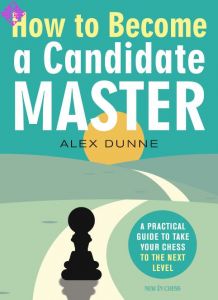 How to become a Candidate Master22,95 €
How to become a Candidate Master22,95 € -
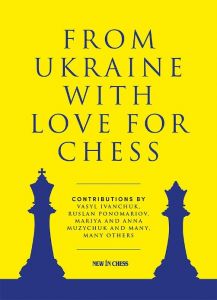 From Ukraine with Love for Chess20,00 €
From Ukraine with Love for Chess20,00 € -
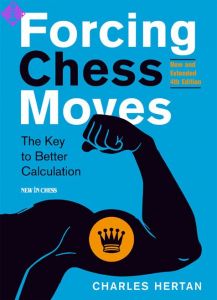 Forcing Chess Moves27,95 €
Forcing Chess Moves27,95 € -
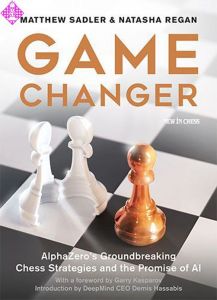 Game Changer22,50 €
Game Changer22,50 € -
 How to Beat Magnus Carlsen14,95 € Regular Price 27,95 €
How to Beat Magnus Carlsen14,95 € Regular Price 27,95 € -
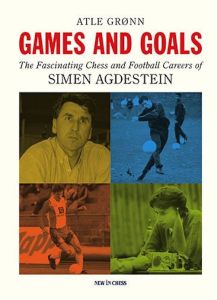 Games and Goals29,95 €
Games and Goals29,95 € -
 Hein Donner - The Biography24,95 €
Hein Donner - The Biography24,95 € - Mehr von New in Chess

